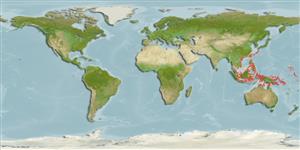>
Ovalentaria/misc (Various families in series Ovalentaria) >
Pomacentridae (Damselfishes) > Pomacentrinae
Etymology: Chrysiptera: Greek, chrysos = golden + Greek, pteron = fin, wing (Ref. 45335).
More on author: Fowler.
Environment: milieu / climate zone / depth range / distribution range
Ecologia
marino associati a barriera corallina; non migratori; distribuzione batimetrica 1 - 16 m (Ref. 7247). Tropical; 30°N - 13°S
Western Pacific: including Solomon Islands, northern Papua New Guinea, Philippines, and Ryukyu Islands. There is a doubtful record from the Great Barrier Reef off Cairns, Australia.
Size / Peso / Age
Maturity: Lm ? range ? - ? cm
Max length : 7.0 cm TL maschio/sesso non determinato; (Ref. 9710)
Short description
Chiavi di identificazione | Morfologia | Morfometria
Spine dorsali (totale) : 13; Raggi dorsali molli (totale) : 10 - 12; Spine anali: 2; Raggi anali molli: 11 - 12.
Adults inhabit coral-rich areas of sheltered lagoon and inshore coral reefs (Ref. 9710). They occur in small groups on Acropora patches (Ref. 48636). Oviparous, distinct pairing during breeding (Ref. 205). Eggs are demersal and adhere to the substrate (Ref. 205). Males guard and aerate the eggs (Ref. 205). Diurnal species (Ref. 113699).
Life cycle and mating behavior
Maturità | Riproduzione | Deposizione | Uova | Fecundity | Larve
Oviparous, distinct pairing during breeding (Ref. 205). Eggs are demersal and adhere to the substrate (Ref. 205). Males guard and aerate the eggs (Ref. 205).
Allen, G.R., 1991. Damselfishes of the world. Mergus Publishers, Melle, Germany. 271 p. (Ref. 7247)
IUCN Red List Status (Ref. 130435: Version 2024-1)
Threat to humans
Harmless
Human uses
Strumenti
Special reports
Download XML
Fonti Internet
Estimates based on models
Preferred temperature (Ref.
123201): 27.3 - 29.3, mean 28.8 °C (based on 1487 cells).
Phylogenetic diversity index (Ref.
82804): PD
50 = 0.5000 [Uniqueness, from 0.5 = low to 2.0 = high].
Bayesian length-weight: a=0.01479 (0.00651 - 0.03363), b=3.00 (2.81 - 3.19), in cm total length, based on LWR estimates for this (Sub)family-body shape (Ref.
93245).
Trophic level (Ref.
69278): 3.4 ±0.45 se; based on food items.
Resilienza (Ref.
120179): Alto, tempo minimo di raddoppiamento della popolazione meno di 15 mesi (Preliminary K or Fecundity.).
Fishing Vulnerability (Ref.
59153): Low vulnerability (10 of 100).
Nutrients (Ref.
124155): Calcium = 156 [95, 311] mg/100g; Iron = 1.06 [0.64, 1.75] mg/100g; Protein = 18.7 [17.6, 19.7] %; Omega3 = 0.161 [0.091, 0.285] g/100g; Selenium = 18.5 [10.0, 37.0] μg/100g; VitaminA = 249 [87, 695] μg/100g; Zinc = 2.01 [1.35, 2.91] mg/100g (wet weight);
